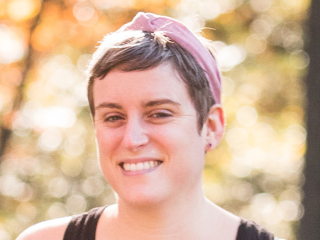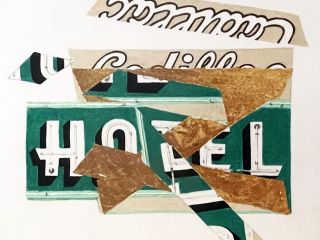Discover the History and Culture of Tacoma through the Eyes of Heather Heckel
 Every artist interprets and views the world differently. But for nationally-renowned and award-winning artist and art educator Heather Heckel, that unique vision is quite literal. As a result of living with double vision her entire life, one of her eyes has become stronger, eliminating depth perception and giving everything the one-dimensional appearance of a portrait. To compensate, she relies heavily on light, shape and shadow to create a three-dimensional world from a flat one. As such, her oil paint and colored pencils artwork focuses on realist, detailed portraits of people, inanimate objects and places. Inspired by a particular place or subject at a time, her work ranges from meditations on the juxtaposition of man and nature to exploring cultural legacies of our public lands.
Every artist interprets and views the world differently. But for nationally-renowned and award-winning artist and art educator Heather Heckel, that unique vision is quite literal. As a result of living with double vision her entire life, one of her eyes has become stronger, eliminating depth perception and giving everything the one-dimensional appearance of a portrait. To compensate, she relies heavily on light, shape and shadow to create a three-dimensional world from a flat one. As such, her oil paint and colored pencils artwork focuses on realist, detailed portraits of people, inanimate objects and places. Inspired by a particular place or subject at a time, her work ranges from meditations on the juxtaposition of man and nature to exploring cultural legacies of our public lands.
 Taking part in artist residencies around the country, most notably as an artist-in-residence for Great Smoky Mountains National Park, to inspire and educate her work as well as take knowledge back to her students, Heckel recently stayed at Hotel Murano in downtown Tacoma as our latest artist-in-residence. After wrapping up her stay, we chatted with her to learn more about what she learned during her residency, the work it inspired and her experience discovering new forms of art in this hub for glassblowing and visual art.
Taking part in artist residencies around the country, most notably as an artist-in-residence for Great Smoky Mountains National Park, to inspire and educate her work as well as take knowledge back to her students, Heckel recently stayed at Hotel Murano in downtown Tacoma as our latest artist-in-residence. After wrapping up her stay, we chatted with her to learn more about what she learned during her residency, the work it inspired and her experience discovering new forms of art in this hub for glassblowing and visual art.
Q: What are some of the most inspirational aspects of your stay?
A: I had the pleasure of staying at Hotel Murano in Tacoma and creating art about Klondike Gold Rush National Historical Park in Seattle. One of the most inspirational aspects of my stay was the incredible amount and diversity of artwork in the hotel. I saw thoughtfully curated art and learned about fellow artists everywhere I looked throughout the lobby, gallery, and individual hotel floors. Additionally, I was on the 22nd floor, and had a beautiful view of the artful city of Tacoma, which I gazed at through my window while I was drawing in my room. Exploring the history of Seattle and the Klondike Visitor Center provided me with the knowledge and photo reference I needed to complete my series of artwork at home once I return to New York.
Q: Do you have a few artists you look up to? Or places you find inspiring that you channel into your work?
A: An artist that I look up to is Marco Wagner, I admire the way he combines technical accuracy with whimsical elements, as well as continually evolving his craft through consistently producing new work. My artwork is site specific, and I find the unique locations of our National Parks an inspiring way to channel my work. My goal is to document a time and place through my artwork, and I find that the style of my artwork differs between each park because I am being influenced by the atmosphere of the setting that I am capturing. Travel always provides me with inspiration.
Q: Are there projects you’ve done to date that are a stand out for you?
A: My series of artist residencies highlighting National Park Service sites stands out for me because it allows me to travel and learn about our country’s history and cultures through total immersion in a place. There is also the knowledge that is learned through creating artwork since I am reimagining what I am seeing into a visual story that I can share with others. I believe the most impactful artist residency to date has been at Hubbell Trading Post National Historic Site because it is located in the heart of Navajo Nation. I had the honor of staying in a traditional guest hogan and learning about local history and culture through Navajo park rangers. I had never been so immersed in another culture, and I believe it is so important to learn about the native people of our country.
Q: What was a notable experience during your time in Tacoma?
A: A notable experience during my time in Tacoma was visiting the Museum of Glass. Before visiting the museum I had not been attracted to glass art, however my experience at the museum completely changed my attitude. My visit started with watching a live glass demonstration where we got to see skilled artisans constructing a glass goblet. I didn’t realize how much teamwork glassblowing requires, and the incredible versatility that the medium allows. The museum showcased an incredibly diverse collection of glass artwork with subjects, textures, and colors that I didn’t know was possible–there appears to be no limit to what is possible using glass.
Q: How does nature/other elements play a role in your art?
A: Traditionally, the National Parks conjure up images of nature, and that has certainly been part of my focus during previous residencies. However, our National Park sites also provide an incredible cultural education, which is the focus of my Hotel Murano artist residency, and was the focus of my other Provenance artist residency at The Old No. 77 Hotel and Chandlery in New Orleans. The focus of my series about the Klondike Gold Rush will be juxtaposing gold leaf, a natural element, with the geometrical shape of gold bricks to represent the movement and fervor of the gold rush that put Seattle on the map.
Q: Is there anything else you would like to share with us about your stay at Murano/in Tacoma?
A: I always consult Atlas Obscura when I travel, and I had the pleasure of visiting several sites listed as things to do in Tacoma, including Bob’s Java Jive, Bridge of Glass, and the Brown & Haley Factory. Also, what is traveling without eating? I highly recommend The Antique Sandwich Co. (especially their marionberry pie), the hot chocolate at Anthem Coffee & Tea, the acai bowls at Eternal Soul Bowl, and the excellent food and customer service at The Fish Peddler.
